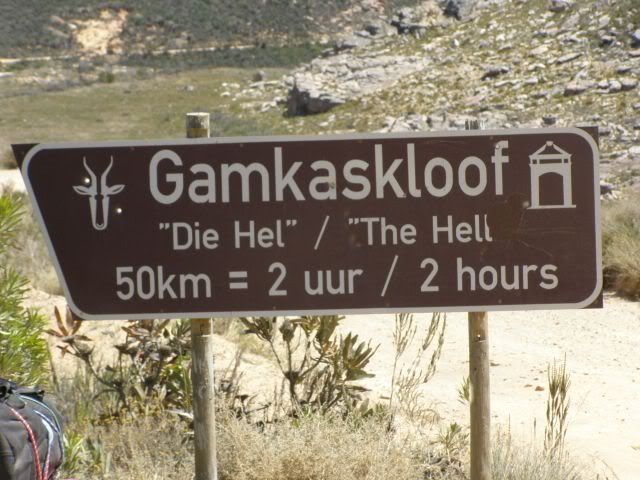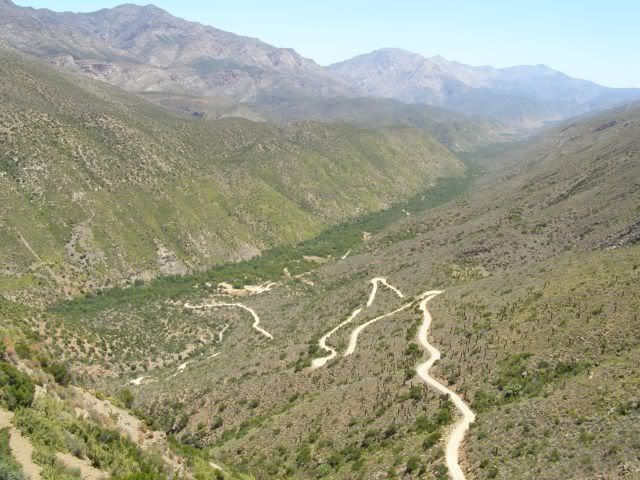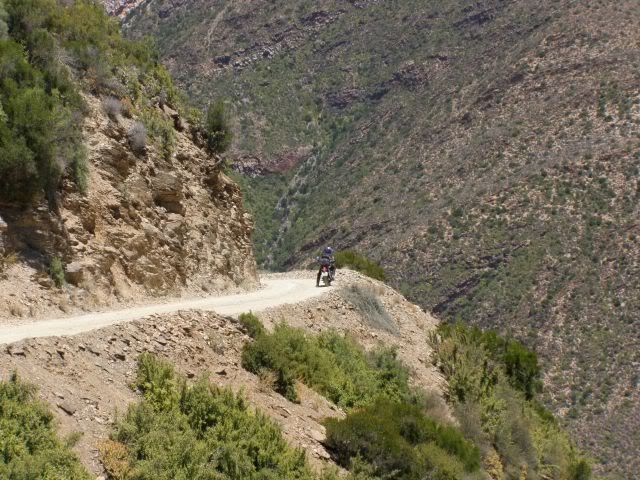Gamkaskloof, also known as "the Hell", is a fascinating valley near Prince Albert (Klein Karoo, South Africa), where a small, proud community lived in isolation for more than 100 years. Petrus Swanepoel was the first to farm there and the valley supported the hard-working community until 1962 when a road was carved into the valley. A gradual exodus occured and the last farmer to leave was Piet Swanepoel in 1991.

History:
The history of this hill-billy community was strange. According to them, a party of trekboers (nomadic farmers) had been wandering along the northern slopes of the Swartberg at the beginning of the 19th century. Smelling water & sweet grazing in the hidden valley, a number of domestic animals owned by the migrant farmers stampeded during the night and found their way through the gorge forced through the Swartberg by the Gamka river which flows directly across the concealed valley. Following the tracks of their missing livestock, the trekboers discovered the valley and were delighted with its perennial water and the farming possibilities of its alluvial soil. It was uninhabited, although the presence of the numerous paintings in caves as well as wooden peg ladders reaching up the precipice faces to wild hives, were proof of the original existence of Bushmen.
The nomadic farmers ended their wandering forthwith and settled in what became known as GAMKAS KLOOF or DIE HEL (the abyss). Eventually 16 small farms were occupied in the valley, and the owners, shut in by the mountains and increasingly disinterested in the outside world, became self dependent, living entirely on the produce of their farms, making their own clothes and indulging in their one luxury - a potent alcoholic beverage made from wild honey.
In 1921 the Dutch Reformed Church established a school in the valley and since then the inhabitants have developed a cash crop of hanepoot grapes which they dry into raisins and convey out of the valley to sell to the outside world. On the proceeds they purchase clothing, sugar, coffee and a few other luxuries. In 1962 a hair-raising road which twists, rises & falls was made into the valley, thereby allowing the advent of representatives of burial societies, insurance agents, sellers of encyclopaedias and politicians at election time, into this once lost valley.

The Boer War:
The Swartberg has had a curiously romantic history. A typical tale about these mountains dates from the period of the Anglo-Boer War. A band of Boer guerrillas raiding into the Little Karoo, found themselves hotly pursued by British soldiers. They determined to cross the Swartberg & to escape into the vast spaces of the Great Karoo where they hoped to rejoin the main body of their commando, led by General Smuts.
Since the passes through the mountains were all closely guarded by the British, the raiders decided to lead their horses directly over the range. They set out to climb the great heights, the horses struggling up the cliff faces and the men sustained by the thought of reaching the summit ridge and then being able to look north into the safety of the Great Karoo. Darkness came before the men had reached the summit, and clouds swept up & enveloped the heights by the time the men finally arrived at the top. Too cold to sleep & with everything too damp to enable them to light a fire, they sat shivering until dawn. They then started to grope their way down the northern face of the mountains which was shrouded in dense mist. It was not until nearly 16h00 that they descended out of the clouds. They expected to find themselves looking down on the Great Karoo, but instead, they were astounded to find beneath them a long, narrow canyon, hemmed in by precipices. On the floor of this ravine 305m below, they could see a few primitive looking mud huts scattered about amongst the aloes and the bush.
Thinking that some tribe of Hottentots must have found a retreat in this eerie place, the Boers left their horses in a ravine and in a body went down to investigate, reaching the bottom just after sunset. As they approached the nearest hut a shaggy giant of a white man, heavily bearded and dressed in goatskins like Robinson Crusoe, appeared and spoke to them in a strange, long drawn out outlandish type of Dutch. He introduced himself as Cordier, who lived in the house with his wife and a brood of half wild children. He knew all about the visitors, for one of his sons had been up in the mountains that morning. Hearing the sound of men and horses, he had stalked the party in the mist, observed their numbers and then slipped down to report to his father.
Cordier was the head of a small community living in the ravine. He offered the visitors a rough but kindly hospitality, feeding them goat’s milk and wild honey. He had vaguely heard of the Anglo-Boer War, but none of the contestants, either British or Boer, had ever penetrated this valley of isolation in the Swartberg.
Cordier guided them out along secret paths across the rugged mountains, until at last they looked down on the northern plains, and so made their escape across the barrier of the Swartberg. This account of how the secret valley was discovered appears in the book COMMANDO, by Deneys Reitz.

The name "The Hell" is attributed to a local stock inspector, who had to make a monthly trek into Gamkaskloof to check stock for disease. The route he followed was down the steep track known as "die leer" - the ladder. On one occasion he said it was like "going to Hell and back" - and it stuck. The Gamkaskloofers DID NOT approve of the name at all.
When a Gamkaskloofer received a letter from the Receiver of Revenue addressed to "The Hell" he sent it back unopened with a note scrawled across the front: "They don't pay tax in Hell."


No comments:
Post a Comment